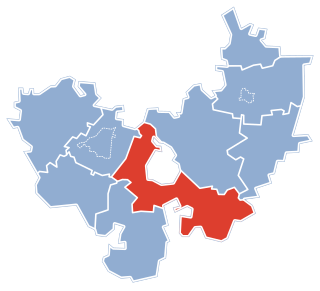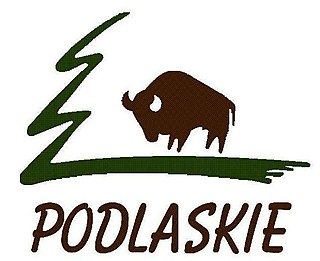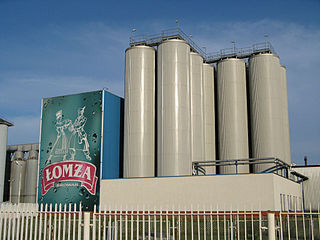
Beer in Poland has been brewed for well over a thousand years and has a significant history of tradition and commercial beer production. Poland is Europe's third largest beer producer, producing 36.9 million hectolitres, coming after the UK with 49.5 million hl and Germany with 103 million hl.

Łomża County is a unit of territorial administration and local government (powiat) in Podlaskie Voivodeship, north-eastern Poland. It came into being on January 1, 1999, as a result of the Polish local government reforms passed in 1998. Its administrative seat is the city of Łomża, although the city is not part of the county. The only towns in Łomża County are Nowogród, which lies 16 km (10 mi) north-west of Łomża, and Jedwabne, 20 km (12 mi) north-east of Łomża.
Łomżyński Klub Sportowy 1926 Łomża is a football club based in Łomża, Poland.

Rafał Boguski is a Polish footballer who plays for Wisła Kraków. He can play in the centre of midfield, on the right and left wing, and as a striker.
Augustów Governorate was an administrative unit (governorate) of the Congress Poland.

Łomża Governorate was an administrative unit (guberniya) of Congress Poland with seat in Łomża.

Gmina Łomża is a rural gmina in Łomża County, Podlaskie Voivodeship, in north-eastern Poland. Its seat is the town of Łomża, although the town is not part of the territory of the gmina.

Gmina Miastkowo is a rural gmina in Łomża County, Podlaskie Voivodeship, in north-eastern Poland. Its seat is the village of Miastkowo, which lies approximately 18 kilometres (11 mi) west of Łomża and 91 km (57 mi) west of the regional capital Białystok.

Gmina Nowogród is an urban-rural gmina in Łomża County, Podlaskie Voivodeship, in north-eastern Poland. Its seat is the town of Nowogród, which lies approximately 16 kilometres (10 mi) north-west of Łomża and 87 km (54 mi) west of the regional capital Białystok.

Gmina Piątnica is a rural gmina in Łomża County, Podlaskie Voivodeship, in north-eastern Poland. Its seat is the village of Piątnica, which lies approximately 3 kilometres (2 mi) north-east of Łomża and 72 km (45 mi) west of the regional capital Białystok.

Gmina Wizna is a rural gmina in Łomża County, Podlaskie Voivodeship, in north-eastern Poland. Its seat is the village of Wizna, which lies approximately 21 kilometres (13 mi) east of Łomża and 54 km (34 mi) west of the regional capital Białystok.

Łomża Landscape Park of the Narew Valley is a protected area in north-eastern Poland, on the banks of the Narew river, close to the town of Łomża, to the south-east.

Podlaskie Voivodeship or Podlasie Province is a voivodeship (province) in northeastern Poland. It borders on Masovian Voivodeship to the west, Warmian-Masurian Voivodeship to the northwest, Lublin Voivodeship to the south, the Belarusian Voblasts of Grodno and Brest to the east, the Lithuanian Counties of Alytus and Marijampolė to the northeast, and the Kaliningrad Oblast of Russia to the north.

Giełczyn is a village in the administrative district of Gmina Łomża, within Łomża County, Podlaskie Voivodeship, in north-eastern Poland. It lies approximately 6 kilometres (4 mi) south of Łomża and 74 km (46 mi) west of the regional capital Białystok.

Modzele-Skudosze is a village in the administrative district of Gmina Łomża, within Łomża County, Podlaskie Voivodeship, in north-eastern Poland. It lies approximately 15 kilometres (9 mi) south-east of Łomża and 68 km (42 mi) west of the regional capital Białystok.

The Browar Łomża is Poland's fourth largest brewery. Browar Łomża Sp. z o.o. launched the plant in 1968. In 2007 it was purchased by Royal Unibrew. In 2011 it was sold to Polish Brewery Van Pur of Warsaw. The Browar Łomża brewery is located in Łomża, Poland.
Łomża Land, named after the town of Łomża, was an administrative unit (ziemia) of both the Kingdom of Poland and the Polish-Lithuanian Commonwealth. It was part of Masovian Voivodeship, and existed from the 14th century until the Partitions of Poland. Łomża Land was the largest province of the historic region of Mazovia.

Battle of Łomża was a series of armed engagements during the Nazi German and Soviet Invasion of Poland. The battle took place in and around the town of Łomża, on both sides of the Narew River. Polish forces successfully held a series of pre-First World War forts from repeated German attack before being forced to withdraw due to the position becoming untenable following their losses at the Battle of Wizna and Battle of Nowogród.



















